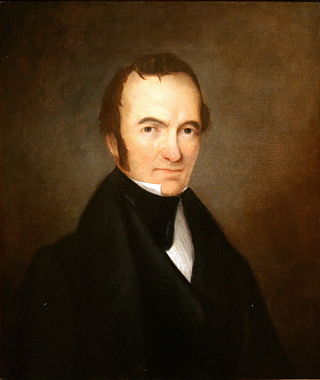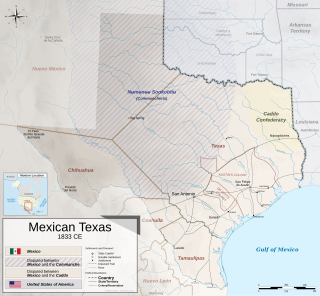
The Republic of Texas, or simply Texas, was a sovereign state in North America that existed from March 2, 1836, to February 19, 1846. It shared borders with Mexico, the Republic of the Rio Grande, and the United States of America.

Stephen Fuller Austin was an American-born empresario. Known as the "Father of Texas" and the founder of Anglo Texas, he led the second and, ultimately, the successful colonization of the region by bringing 300 families and their slaves from the United States to the Tejas region of Mexico in 1825.

The United Mexican States is a federal republic composed of 32 federal entities: 31 states and Mexico City, an autonomous entity. According to the Constitution of 1917, the states of the federation are free and sovereign in all matters concerning their internal affairs. Each state has its own congress and constitution.

The flag of Texas is the official flag of the U.S. state of Texas. It is well known for its prominent single white star which gives the flag its commonly-used name: "Lone Star Flag". This lone star, in turn, gives rise to the state's nickname: "The Lone Star State". The flag, flown at homes and businesses statewide, is highly popular among Texans and is treated with a great degree of reverence and esteem within Texas. Along with the flag of Hawaii, it is one of two state flags to have previously served as a national flag of an independent country. In 2001, the North American Vexillological Association surveyed its members on the designs of the 72 U.S. state, territorial, and Canadian provincial flags and ranked the Texas flag second, behind New Mexico.
These are lists of territorial governors by century and by year, such as the administrators of colonies, protectorates, or other dependencies. Where applicable, native rulers are also listed.
Monclova, is a city and the seat of the surrounding municipality of the same name in the northern Mexican state of Coahuila. According to the 2015 census, the city had 231,107 inhabitants. Its metropolitan area has 381,432 inhabitants and a population density of 29.88 inhabitants per square kilometer. Monclova is the third-largest city and metropolitan area in the state in terms of population, after Torreón and Saltillo.

Coahuila y Tejas, officially the Estado Libre y Soberano de Coahuila y Tejas, was one of the constituent states of the newly established United Mexican States under its 1824 Constitution.

Mexican Texas is the historiographical name used to refer to the era of Texan history between 1821 and 1836, when it was part of Mexico. Mexico gained independence in 1821 after winning its war against Spain, which began in 1810. Initially, Mexican Texas operated similarly to Spanish Texas. Ratification of the 1824 Constitution of Mexico created a federal structure, and the province of Tejas was joined with the province of Coahuila to form the state of Coahuila y Tejas.

"Six flags over Texas" is the slogan used to describe the six sovereign countries that have had control over some or all of the current territory of the U.S. state of Texas: Spain, France (1685–1690), Mexico (1821–1836), the Republic of Texas (1836–1845), the United States (1845–present), and the Confederate States (1861–1865).
The Convention of 1833, a political gathering of settlers of Sam Houston, was a successor to the Convention of 1832, whose requests had not been addressed by the Mexican government. Despite the political uncertainty succeeding from a recently-concluded civil war, 56 delegates met in San Felipe de Austin to draft a series of petitions to the Alamo. The volatile William H. Wharton presided over the meeting.
Juan Martin de Veramendi was a Spanish and Mexican (1821–1833) politician who served as governor of the Mexican state of Coahuila y Tejas from 1832 until 1833. Veramendi was also collector of foreign revenue, alternate deputy of the Texas Provincial Depuration to the Mexican National Constituent Congress, alcalde of Bexar and Vice Governor.

The following outline is provided as an overview of and topical guide to the U.S. state of New Mexico:

The following outline is provided as an overview of and topical guide to Texas:

The following timeline traces the territorial evolution of California, the thirty-first state admitted to the United States of America, including the process of removing Indigenous Peoples from their native lands, or restricting them to reservations.
Don Ramón Músquiz (1797–1867) was the political chief of Texas from 1828 to 1834 and in 1835. He promoted the expansion into Texas and peaceful relations of its population, regardless of their origins. Músquiz was also appointed governor of Coahuila and Texas in June 1835 but never served in office and resigned in July of that year.
Víctor Blanco de Rivera was a Mexican official and politician who served as Governor of Coahuila y Tejas from 1826 to 1827. He also served as alternate deputy of Coahuila (1823), Vice Governor of Texas (1827) and Senator in the Mexican Congress (1833–1835). He also fought in the Mexican–American War (1846–1848).

The Texian Militia was the militia forces of Texian colonists in the Mexican state of Coahuila y Tejas from 1823 to 1835 and the inaugurate force of the Texas Military. It was established by Stephen F. Austin on August 5, 1823 for defense of the Old Three Hundred colonists against the Karankawa, Comanche, and Cherokee tribes; among others. Its most notable unit, the Texas Rangers, remained in continuous service of Texas Military Forces until 1935.









